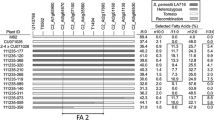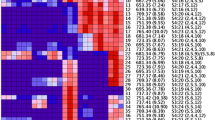Abstract
Acylsugars are broad-spectrum insect resistance sugar esters produced at very high levels by some accessions of the wild tomato, Solanum pennellii. Transferring acylsugar production from S. pennellii LA716 to cultivated tomato through traditional breeding developed the benchmark acylsugar breeding line CU071026. The base moiety of acylsugars (sucrose vs. glucose) can vary among S. pennellii accessions. Additionally the accession S. pennellii LA716 produces almost exclusively acylglucoses, but the breeding line CU071026 derived from S. pennellii LA716 produces exclusively acylsucroses. This study uses a BC1F1 and a BC1F2 population derived from the cross CU071026 × (CU071026 × S. pennellii LA716) to identify and confirm the action of three quantitative trait loci (QTL) on chromosomes 3, 4, and 11. The QTL on chromosomes 3 and 11 are both required for acylglucose production, while addition of the chromosome 4 QTL affects the level of acylglucose produced in the presence of the QTL on chromosomes 3 and 11. A three-way interaction between these acylglucose QTL was confirmed with a post hoc ANOVA. Identification of these three QTL provides a blueprint for breeding to shift acylsucrose production to acylglucose production in tomato breeding lines. The implications of these QTL and two additional QTL affecting total acylsugar level in the BC1F2 are discussed.

Similar content being viewed by others
References
Blauth SL, Churchill GA, Mutschler MA (1998) Identification of QTL associated with acylsugar accumulation using intraspecific populations of the wild tomato Lycopersicon pennellii. Theor Appl Genet 96:458–467
Burke B, Goldsby G, Mudd JB (1987) Polar epicuticular lipids of Lycopersicon pennellii. Phytochemistry 26:2567–2571
Buta GJ, Lusby WR, Neal JW Jr, Waters RM, Pittarelli GW (1993) Sucrose esters from Nicotiana gossei active against the greenhouse whitefly Trialeuroides vaporarium. Phytochemistry 32:859–864
Churchill GA, Doerge RW (1994) Empirical threshold for quantitative trait mapping. Genetics 138:963–971
Cutler HG, Severson RF, Cole PD, Jackson DM, Johnson AW (1986) Secondary metabolites from higher plants. Their possible role as biological control agents. In: Green MB, Hedin PA (eds) Natural resistance of plants to pests. American Chemical Society, Washington, DC, pp 178–196
Elle E, van Dam NM, Hare JD (1999) Cost of glandular trichomes, a “resistance” character in Datura wrightii Regel (Solanaceae). Evolution 53:22–35
Eshed Y, Zamir D (1994) A genomic library of Lycopersicon pennellii in L. esculentum: a tool for fine mapping of genes. Euphytica 79:175–179
Fobes JF, Mudd J, Marsden M (1985) Epicuticular lipid on the leaves of L. pennellii and L. esculentum. Plant Physiol 77:567–570
Ghangas GS, Steffens JC (1993) UDPglucose: fatty acid transglucosylation and transacylation in triacylglucose biosynthesis. Proc Natl Acad Sci USA 90:9911–9915
Ghangas GS, Steffens JC (1995) 1-O-Acyl-beta-D-glucoses as fatty acid donors in transacylation reactions. Arch Biochem Biophys 316:370–377
Gibson RW (1976) Trapping of the spider mite Tetranychus urticae by glandular hairs on the wild potato Solanum berthaultii. Potato Res 19:179–182
Gibson RJ, Valencia L (1978) A survey of potato species for resistance to the mite Polyphagotarsonemus latus, with particular reference to the protection of Solanum berthaultii and S. tarijense by glandular hairs. Potato Res 21:217–223
Goffreda JC, Mutschler MA (1989) Inheritance of potato aphid resistance in hybrids between Lycopersicon esculentum and L. pennellii. Theor Appl Genet 78:210–216
Hanlon P, Lorenz WA, Shao Z, Harper JM, Galecki AT, Miller RA, Burke DT (2006) Three-locus and four locus QTL interactions influence mouse insulin-like growth factor-I. Physiol Genomics 26:46–54
Hare JD (2005) Bioactivity of acylglucose esters from Datura wrightii glandular trichomes against three native insect herbivores. J Chem Ecol 31:1475–1491
Hare JD, Elle E, van Dam NM (2003) Costs of glandular trichomes in Datura wrightii: a three-year study. Evolution 57:793–805
Hawthorne DM, Shapiro JA, Tingey WM, Mutschler MA (1992) Trichome-borne and artificially applied acylsugars of wild tomato deter feeding and oviposition of the leafminer, Liriomyza trifolii. Entomol Exp Appl 65:65–73
Holley JD, King RR, Singh RP (1987) Glandular trichomes and the resistance of Solanum berthaultii (PI 473340) to infection from Phytophthora infestans. Can J Plant Pathol 9:291–294
Juvik J, Shapiro JA, Young TE, Mutschler MA (1994) Acylglucoses of the wild tomato Lycopersicon pennellii alter behavior and reduce growth and survival of Helicoverpa zea and Spodoptera exigua. J Econ Entomol 87:482–492
Kennedy BS, Nielsen MT, Severson RF, Sisson VA, Stephenson MK, Jackson DM (1992) Leaf surface chemicals from Nicotiana affecting germination of Peronospora tabacina sporangia. J Chem Ecol 18:1467–1479
Kuai JP, Ghangas GS, Steffens JC (1997) Regulation of triacylglucose fatty acid composition—uridine diphosphate glucose fatty acid glucosyltransferases with overlapping chain-length specificity. Plant Physiol 115:1581–1587
Leckie BM, DeJong DM, Mutschler MA (2012) Quantitative trait loci increasing acylsugars in tomato breeding lines and their impacts on silverleaf whiteflies. Mol Breed 30:1621–1634. doi:10.1007/s11032-012-9746-3
Li AX, Steffens JC (2000) An acyltransferase catalyzing the formation of diacylglucose is a serine carboxypeptidase-like protein. Proc Natl Acad Sci USA 97:6902–6907
Li AX, Eannetta N, Ghangas GS, Steffens JC (1999) Glucose polyester biosynthesis. Purification and characterization of a glucose acyltransferase. Plant Physiol 121:453–460
Liedl BE, Lawson DM, White KK, Shapiro JA, Cohen DE, Carson WG, Trumble JT, Mutschler MA (1995) Acylglucoses of the wild tomato Lycopersicon pennellii alters settling and reduces oviposition of Bemisia argentifolii. J Econ Entomol 88:742–748
Manly KF, Cudmore RH Jr, Meer JM (2001) Map Manager QTX, cross-platform software for genetic mapping. Mamm Genome 12:930–932
McNally KL, Mutschler MA (1997) Use of introgression lines and zonal mapping to identify RAPD markers linked to QTL. Mol Breed 3:203–212
Mutschler MA, Doerge RW, Liu J, Kuai JP, Liedl B, Shapiro Y (1996) QTL analysis of pest resistance in the wild tomato, Lycopersicon pennellii: QTL controlling acylsugar level and composition. Theor Appl Genet 92:709–718
Neal JJ, Tingey WM, Steffens JC (1989) Glandular trichomes of Solanum berthaultii and resistance to the Colorado potato beetle. Entomol Exp Appl 51:133–140
Neal JJ, Tingey WM, Steffens JC (1990) Sucrose esters of carboxylic acids in glandular trichomes of Solanum berthaultii deter settling and probing by green peach aphid. J Chem Ecol 16:487–497
Rodriguez AE, Tingey WM, Mutschler MA (1993) Acylsugars produced by type IV trichomes of Lycopersicon pennellii (Corr.) D’Arcy deter settling of the green peach aphid, Myzus persicae (Sulzer) (Homoptera: Aphididae). J Econ Entomol 86:34–39
SAS Institute Inc. (2010) JMP 9 user guide. SAS Institute Inc., Cary, NC
Schilmiller A, Shi F, Kim J, Charbonneau A, Holmes D, Jones AD, Last RL (2010) Mass spectrometry screening reveals widespread diversity in trichome specialized metabolites of tomato chromosomal substitution lines. Plant J 62:391–403
Severson RF, Johnson AW, Jackson DM (1985) Cuticular constituents of tobacco: factors affecting their production and their role in insect and disease resistance and smoke quality. Recent Adv Tob Sci 11:105–174
Shapiro J, Steffens J, Mutschler MA (1994) Acylsugars of the wild tomato Lycopersicon pennellii in relation to its geographic distribution. Biochem Syst Ecol 22:545–561
Slocombe SP, Schauvinhold I, McQuinn RP, Besser K, Welsby NA, Harper A, Aziz N, Li Y, Larson TR, Giovannoni J, Dixon RA, Broun P (2008) Transcriptomic and reverse genetic analyses of branched-chain fatty acid and acyl sugar production in Solanum pennellii and Nicotiana benthamiana. Plant Physiol 148:1830–1846
Wilkens RT, Shea GO, Halbreich S, Stamp NE (1996) Resource availability and trichome defenses of tomato plants. Oecologia 106:181–191
Yang J, Hu C, Hu H, Yu R, Xia Z, Ye X, Zhu J (2008) QTLNetwork: mapping and visualizing genetic architecture of complex traits in experimental populations. Bioinformatics 24:721–723
Acknowledgments
We would also like to thank Jean-Luc Jannink for valuable discussions on epistasis. This study was funded by the Hatch funds (NYC-149440) and the Cornell University Vegetable Breeding Institute.
Conflict of interest
The authors have declared no conflict of interests.
Author information
Authors and Affiliations
Corresponding author
Electronic supplementary material
Below is the link to the electronic supplementary material.
Rights and permissions
About this article
Cite this article
Leckie, B.M., De Jong, D.M. & Mutschler, M.A. Quantitative trait loci regulating sugar moiety of acylsugars in tomato. Mol Breeding 31, 957–970 (2013). https://doi.org/10.1007/s11032-013-9849-5
Received:
Accepted:
Published:
Issue Date:
DOI: https://doi.org/10.1007/s11032-013-9849-5




